Blogs are an effective way to promote one’s website organically and increase web traffic. In this regard, ODL is a renowned name among content writing agencies. See yourself the example of one of our clients Imprezz whose web traffic increased manifold between June 2020 to September 2020.
Almost a year ago, Imprezz, a free billing and invoicing software struggled to find a solid ground for the blogs on their website. One question became part of the heated debates taken in their board meetings:
“How can our blogs gain ground and reach a threshold of more than 10,000 visitors every month in as little time as we can?
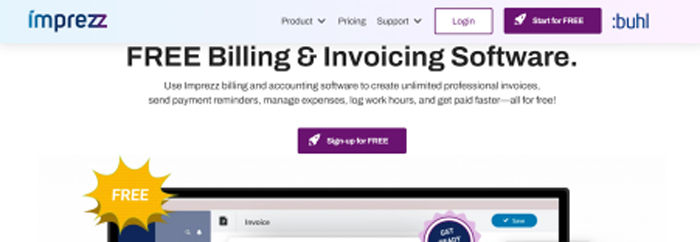
“We were crafting and designing our blogs, as best as we could. Still, we could not find what we were doing wrong.”, says Amit Mudra, Imprezz). He adds, “however, one interesting suggestion came up in one of our board meetings. A member pointed out that our expertise lies somewhere else, not in creating attractive blogs. The member suggested the board hire a specialized content writing agency, to which all of us agreed.”
This case study focuses on this mammoth question: how can you grow blog traffic to reach more than 10,000+ visitors every month. With the help of data and graphs, let us see how our blog writing services helped Imprezz catapult its blog traffic in the course of fewer than three months. I will be breaking down this entire process in several steps to better present the picture behind the attractive blogs that you see:
Step 1: Creating A Blog Plan
Picking the Topics
After understanding our client inside out, the most critical task at hand was picking the broad topics we could use for the blogs. We generally surf through Google, BuzzSumo, Facebook groups, etc., to try to identify the topics that are most relevant for that particular niche.
In the case of Imprezz, we went on all these different platforms to identify what interests our target audience, what they want to know about invoicing and billing services, and what particular requirements they have.
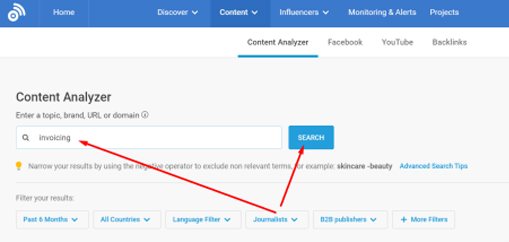
The attached screenshots present how we identified the relevant topics from BuzzSumo with high engagement.

Creating an Initial Article List
After identifying broad topics, we extract article (or blog) titles from them and create an initial list of articles that we can write based on all these topics. Finally, we keep all these article titles in a spreadsheet and share them with a client for approval. This allows us to choose the best article titles available and ensure that we are not writing haphazardly. This is what we term a Content Plan.
As you can see in the screenshot, we created a long list of articles for Imprezz that could be written in the month of September 2020. Then, we shared it with the client to get them on board with our ideas. We have found that putting all the articles in one list helps in numerous follow-up tasks like content auditing, keyword research, and competitor analysis. But we will get there a little while later.
After selecting the titles, we designated a word count for each of the articles (already discussed with the client).
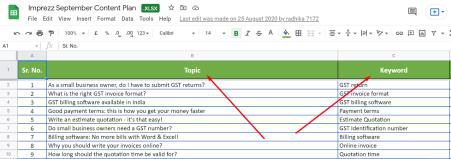
Then, we would make a focused keyword column where we keep the most prominent keyword we are going to use in the article.
We use KWFinder to find the focused keywords. The screenshot shows how we select a focused keyword on this particular keyword planner tool.

Another column can be seen in the screenshot where we generally add region-specific keyword search volume (it could be worldwide keyword search volume also, based on the particular client’s requirements).

We have also added a new worksheet that lists all the targeted keywords. These keywords appear regularly in the articles and boost SEO optimization.
Now, these are our ingredients for the meaty and more in-depth blogs with higher SEO value.
Step 2: Prioritizing Your Article
Now that we have a list of potential topics, it makes sense to create a schedule where we can assign possible dates for these articles to be completed and published. Like this:
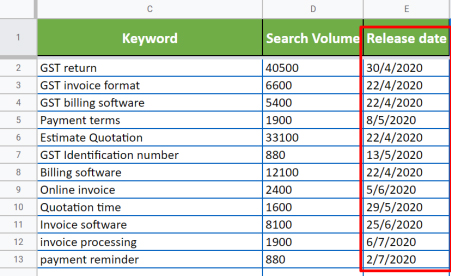
We generally use criteria to prioritize the topics and keywords and disqualify those that have high competitiveness and difficulty, respectively.
Based on Keyword Difficulty
First of all, we explore what is the keyword difficulty selected from BuzzSumo. Ideal keywords would be that with the perfect union of high volume but low difficulty rate.

We compare the search results and choose a keyword that is least difficult but with higher volume. Look at the screenshot below. The results show a moderate rate of difficulty which means we are good to go:

Based on Low Competitive Ranking
Once I am done selecting the keywords on the basis of their difficulty, I run them through the same Moz keyword toolbar to get an analysis of their competitiveness. Competitive is an analysis of who others are ranking these keywords on the search engine. Another simple way is just to search the focused keywords on search engines like Google. If a few smaller sites compete to get ranked for a particular keyword, we definitely work on those to get the maximum traction.
Step 3: Pick Top 5-10 Topics
From a mammoth list that we prepared in the beginning, we are now down to a few selected topics. Now, comes the time when we select the top 5-10 topics (excluding the ones with high competition) that would be published on the website.
Only 5-10 highly SEO-optimized topics with well-researched content can bring more than 10k visitors monthly. In fact, Imprezz received approximately 2,200 daily visitors from three of the 10 blogs that we published in the month of September 2020. The following snapshot shows the number of hits on Imprezz website in a single day of September (i.e., September 14th).
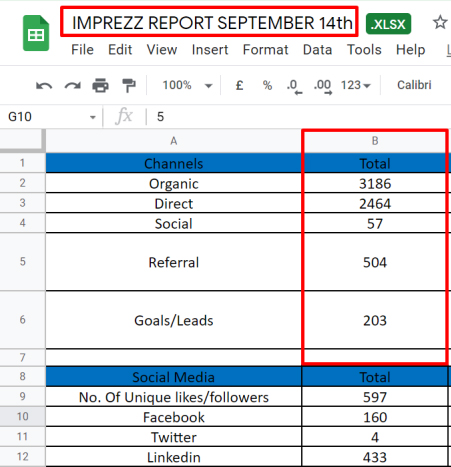
Just to let you know, the performance of each blog cannot be evenly spread. However, some of those can definitely cross the mark of 3000 visitors monthly.
Step 4: Write the First Article
Finally, it is time to pick a topic and take down what you want. However, I feel it would be best to follow certain guidelines that I also follow. Here goes:
- Write something that pushes the reader to take charge and be actionable. For example, avoid scribbling something that someone reads, appreciates but then forgets.
- Follow one single core idea throughout. It would be hazardous if you tried to present a mocktail in your article and mess with the reader’s head. Think about what the
reader would search for on a search engine and what could be the best possible answer to that query.
- Before you attempt to write, give a thought to how you can make it an all-encompassing article so that when someone reads it, they do not need to find any other piece to seek further information. In addition, it must compel the readers to say, “I better save this for future reference.”
- For length, I feel that 1500-3000 words would do as I like to keep my articles crisp. I believe that the attention span is becoming narrower these days, and readers would definitely lose interest just as they see it is really long.
- The most valuable advice that I can bring to the table is: to use pictures and illustrations. It has rightly been said that a picture can speak a thousand words, and thus, use pictures to enhance the narrative of your content. However, it must be remembered that these pictures must add value to your article. Therefore, these can not be any random stock images.
- I get lost whenever I read an article without any headings, subheadings, and proper division of paragraphs and doze off as soon as I begin. So, it is best to chunk up your content.
- Back it up with Backlinks. Always add backlinks to your content because its benefits are twofold. First, it makes your article look more authentic, and second, plugging more people or entities would also let you email them to share the content.
- Link your previous articles as well because if this article gets heavy traffic, then some of it can also be redirected towards other articles published on your website.
Don’t think these rules as exhaustive, but they will certainly help you boost traffic to your website. For example, if you want your article to be perfectly optimized for SEO, You can install and use Yoast to check if the keywords are ideally placed to rank the article on search engines.
Step 5: Promote Your Article
You cannot just wait for Google or any other search engine to pick your article up and cross the 10k visitors mark. Opportunities waste no time to come to those who are unprepared. Therefore, take charge and use the potential of social media and other channels to promote your website and increase traffic. As more and more people begin to read and link your article, the SEO juice kicks in, and search engines also start to promote such articles on ranking indexes.
I would suggest the following methods to organically promote your blogs (as this is what our clients, along with us, have done):
Email to Your List
Do you have a list of emails to whom you can send the link to your latest uploads?
Don’t you? No worries, mail your friends and colleagues to read your latest piece and ask them to share it with their friends. Then, take another piece of advice and start an email subscription for your visitors. It would send subscribed visitors an email notification as soon as you publish a new blog.
Harness the Potential of Reddit Communities
Where do you think newbie bloggers go to promote their blogs? Of course, Reddit. Follow a few simples steps, and you will see results as soon as you jump on board Reddit’s communities:
- Find a Reddit community or subreddit that matches the content you create. ● Ensure that they allow link sharing in the community posts.
- Make sure that you earn karma points to share the link to the blogs you have published on your website. Karma points can be earned by engaging with other posts (liking or posting a comment).
Go Social with the Social Media
Sharing your blog on social media platforms like Facebook, Twitter, Instagram, etc., helps drive traffic and boost engagement on your blog. In addition, you can publicize your blogs by posting summaries or a few of your original content to give them a taste of your best content.
The Bottom Line
One Digital Land is a renowned name among content writing agencies. What differentiates us from our competitors is the processes we adopt when attempting to create content for our clients. We throw ourselves entirely at the client’s service so that we can deliver the content that our clients and that suits them the best. We also know that our clients mostly come from the SaaS industries with expertise in constant innovation and cutting-edge technologies. This is why they often do not understand the better practices in content creation that we know.
In the end, we have an expert team of writers, each specializing in a different sector and having experience working in that particular niche. This helps us provide our clients with the most relevant content with no nonsense approach. We had a blast in the previous year, and now we are all equipped with the new content writing trends that will dominate 2022. Therefore, let us be a part of the journey where you, too, can organically increase your web traffic manifold with best-in-class blogging services.

